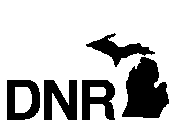
Off site resource => Original referring URL
to Central States North trip - June 2-15, 1977
Nayanquing Point Wildlife Area is reached by taking I-75 to either the Pinconning exit (from the north) or the Linwood exit (from the south) and heading east to M-13. Signs for the wildlife area are found at the intersection of M-13 and Kitchen Road, three miles north of Linwood Road. Follow Kitchen Road east to Nayanquing Point.
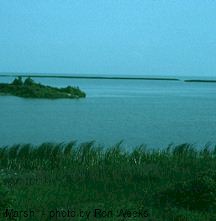 Nayanquing Point
is one of the most visited areas in Saginaw Bay for water birds. It is also home to one of
the oldest and largest colonies of Yellow-headed Blackbirds in the state. In the spring
and fall, Nayanquing is home to huge numbers of migrating waterfowl and smaller numbers of
gulls and shorebirds. Such finds as Trumpeter Swan (banded bird from Minnesota
population), Greater White-fronted Goose, Cinnamon Teal, Arctic Tern, Little, Franklin's,
Laughing, and Lesser Black-backed Gulls and Long-tailed Jaeger have been noted in recent
years. Many waterfowl are seen in the summer months as this area also hosts a wide variety
of nesting ducks. Species such as Green-winged Teal, American Black Duck, Northern
Pintail, Northern Shoveler, Gadwall, American Wigeon, and Redhead are noted here in small
numbers each summer. Nayanquing Point can also be excellent for herons, gulls, terns,
shorebirds, and passerines in season. Snowy Egret, Little Blue and Tri-colored Herons,
White-faced and Glossy Ibises, Hudsonian and Marbled Godwits, and Ruff have been found
here. Some of the more interesting residents include Pied-billed Grebe, Black-crowned
Night-Heron, American and Least Bitterns, Common Moorhen, Ring-necked Pheasant, Black and
Forster's Terns, Marsh and Sedge Wrens, and Willow Flycatcher.
Nayanquing Point
is one of the most visited areas in Saginaw Bay for water birds. It is also home to one of
the oldest and largest colonies of Yellow-headed Blackbirds in the state. In the spring
and fall, Nayanquing is home to huge numbers of migrating waterfowl and smaller numbers of
gulls and shorebirds. Such finds as Trumpeter Swan (banded bird from Minnesota
population), Greater White-fronted Goose, Cinnamon Teal, Arctic Tern, Little, Franklin's,
Laughing, and Lesser Black-backed Gulls and Long-tailed Jaeger have been noted in recent
years. Many waterfowl are seen in the summer months as this area also hosts a wide variety
of nesting ducks. Species such as Green-winged Teal, American Black Duck, Northern
Pintail, Northern Shoveler, Gadwall, American Wigeon, and Redhead are noted here in small
numbers each summer. Nayanquing Point can also be excellent for herons, gulls, terns,
shorebirds, and passerines in season. Snowy Egret, Little Blue and Tri-colored Herons,
White-faced and Glossy Ibises, Hudsonian and Marbled Godwits, and Ruff have been found
here. Some of the more interesting residents include Pied-billed Grebe, Black-crowned
Night-Heron, American and Least Bitterns, Common Moorhen, Ring-necked Pheasant, Black and
Forster's Terns, Marsh and Sedge Wrens, and Willow Flycatcher.
From the intersection of Tower Beach and Kitchen Roads head east and follow Kitchen
until the road turns toward the south. Stop here and check the unit due east of
the corner (A). A large shallow pond bordered by cattails supports a variety of birds
including Marsh Wren and Swamp Sparrow. The pond itself may be good for shorebirds, gulls,
and terns when the water is low. This pond was much better for birding before it was
sealed off from the influence of the lake level in the interest of maintaining minimum
levels for nesting waterfowl. Herons, egrets, cormorants, and numerous waterfowl use this
pond for feeding and loafing. Some of the better finds include American White Pelican,
American Avocet, and Marbled Godwit. Continue south on Kitchen until it dead ends near an
observation tower. This tower is an excellent vantage point from which to view a large
part of the wildlife area. This tower was recently improved as part of a project by the Saginaw Bay Watershed Initiative Network to improve birding in the
region. A good deal of the bay may be scanned to the south and east (B). Check the
field unit to the northwest for wet areas which often attract waterfowl and shorebirds
(C). The field is among the best areas for observing Wilson's Phalaropes which are
sometimes common through the summer and probably have nest here. In times of passerine
migration in late August and September the strip of trees that runs from the tower area
north along the lakeshore is excellent (D). Since no other habitat exists in the area,
this strip of brush and trees tends to concentrate migrants. The beach along this strip of
trees is sometimes good for shorebirds.
Return to the bend in Kitchen Road and enter a parking area just west of the corner.
This parking area is the best spot from which to explore the northern units of the refuge.
Nearly every April the fields just west of the parking area are home to one or more
Short-eared Owls which are most often seen by scanning the fields just before dark (E).
Follow the dike from the parking lot as it works its way north and east through fields and
marsh (F). This habitat has changed slowly through the years. The wet areas along this
dike are occasionally home to the state-endangered King Rail. Be cautious as this area is
also home to the smaller but very similar-sounding Virginia Rail. The brush along these
dikes can also be good for sparrows and other passerines in migration. A Harris' Sparrow
frequent the marshes here. Continue east on the dike to the lake or west and around the
canal to the opposite side for a closer look. The walk to the lake allows for more viewing
of open ponds to the north and lakeshore viewing to the east. It is possible to walk along
the bay all the way back to the tower and totally circle the 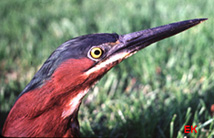 inland pond, but this is quite a long and
difficult walk particularly if lake levels are high.
inland pond, but this is quite a long and
difficult walk particularly if lake levels are high.
After returning to Kitchen Road, head back to Tower Beach Road and turn right. Head north for one mile and turn right on Erickson Road. After traveling about one-half mile, a farm house will be visible on your left. Park in the area immediately across the road from the house (H). This area can be good in migration for a variety of passerines, especially cuckoos. It is also a good location for Willow Flycatcher. Next continue on Erickson east to the bay. A walk to the south along the bay leads along a series of ponds that are good for a variety of waterfowl in spring and fall (I). Sometimes these ponds can be good for Green Heron, Wood Duck, Common Moorhen, and Belted Kingfisher. Farther south along the beach, bitterns and rails are often heard calling at dawn or dusk. Scan the lake for herons, egrets, shorebirds (if there is a muddy edge), and waterfowl. Similar habitat and more woodlands may be found one mile north at the end of Coggins Road.
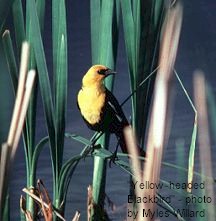 The most
productive units for interesting water birds are part of the Wildlife Refuge and are
closed to normal entry. The current manager is very good about granting access to these
southern units of the refuge. This is, of course, subject to change and permission should
always be obtained before entering these areas. The best of the southern units is reached
by parking at the south end of Tower Beach Road (J). Walk about one-half mile to where the
dike Ts. The dike between the parking lot and the T is excellent for Willow Flycatcher and
Sedge and Marsh Wrens. Upon reaching the T, the best birding is on the lake side which is
reached by turning left. If ambitious, hike the entire loop around this cattail-filled
pond (K). This unit has been home to many rarities, but it is especially good for southern
wading birds. The best find in recent years was an adult White-faced Ibis that spent a few
days here in June of 1990. This pond is also home to Least Bittern, Common Moorhen,
Forster's and Black Terns, Yellow-headed Blackbird, and the best variety of summering
waterfowl in the SBA.
The most
productive units for interesting water birds are part of the Wildlife Refuge and are
closed to normal entry. The current manager is very good about granting access to these
southern units of the refuge. This is, of course, subject to change and permission should
always be obtained before entering these areas. The best of the southern units is reached
by parking at the south end of Tower Beach Road (J). Walk about one-half mile to where the
dike Ts. The dike between the parking lot and the T is excellent for Willow Flycatcher and
Sedge and Marsh Wrens. Upon reaching the T, the best birding is on the lake side which is
reached by turning left. If ambitious, hike the entire loop around this cattail-filled
pond (K). This unit has been home to many rarities, but it is especially good for southern
wading birds. The best find in recent years was an adult White-faced Ibis that spent a few
days here in June of 1990. This pond is also home to Least Bittern, Common Moorhen,
Forster's and Black Terns, Yellow-headed Blackbird, and the best variety of summering
waterfowl in the SBA.
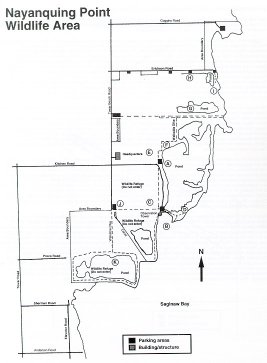
Excerpted from Birds and Bird Finding in the Saginaw Bay Area by Ron J. Weeks